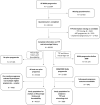The association between miscarriage and fecundability: the Norwegian Mother, Father and Child Cohort Study
- PMID: 34792121
- PMCID: PMC8804331
- DOI: 10.1093/humrep/deab252
The association between miscarriage and fecundability: the Norwegian Mother, Father and Child Cohort Study
Abstract
Study question: Is fecundability associated with miscarriage history and future miscarriage risk?
Summary answer: Prior miscarriage was associated with lower fecundability, and participants with a history of subfertility (time-to-pregnancy (TTP) ≥12 months) were at a higher risk of subsequent miscarriage.
What is known already: Although miscarriage and low fecundability share common risk factors, prior studies have reported both lower and higher fecundability after miscarriage.
Study design, size, duration: In this study, we examined two related associations: one, between miscarriage history and subsequent fecundability and, two, between fecundability and miscarriage risk in the subsequent pregnancy. The study is based on the Norwegian Mother, Father and Child Cohort Study (MoBa). In addition, the outcome of the pregnancy after the MoBa index pregnancy was obtained by linking information from three national health registries: the Medical Birth Registry of Norway, the Norwegian Patient Registry and the general practice database.
Participants/materials, setting, methods: We examined the association between number of prior miscarriages and fecundability in 48 537 naturally conceived, planned pregnancies in participants with at least one prior pregnancy. We estimated fecundability ratios (FRs) and 95% CIs using proportional probability regression. We further estimated the relative risk (RR) of miscarriage in the subsequent pregnancy as a function of TTP in the MoBa index pregnancy for 7889 pregnancies using log-binomial regression. Multivariable analyses adjusted for maternal age, pre-pregnancy maternal BMI, smoking status, cycle regularity, income level and highest completed or ongoing education.
Main results and the role of chance: Fecundability decreased as the number of prior miscarriages increased. The adjusted FRs among women with one, two and three or more prior miscarriages were 0.83 (95% CI: 0.80-0.85), 0.79 (95% CI: 0.74-0.83) and 0.74 (95% CI: 0.67-0.82), respectively, compared with women with no prior miscarriages. Compared to women with a TTP of <3 months, the adjusted RR of miscarriage in the subsequent pregnancy was 1.16 (0.99-1.35) with TTP of 3-6 months, 1.18 (0.93-1.49) with TTP of 7-11 months and 1.43 (1.13-1.81) with TTP of 12 or more months.
Limitations, reasons for caution: Information on TTP and prior miscarriages was obtained retrospectively, and TTP was self-reported. MoBa is a pregnancy cohort, and findings may not be generalizable to all women. We were unable to examine the effect of changing partners between pregnancies, as well as other paternal factors such as seminal parameters. We also did not know what proportion of our participants had changed partners between their prior pregnancies and the index pregnancy. Furthermore, it is likely that many early miscarriages are not recognized.
Wider implications of the findings: The association between miscarriage and fecundability may reflect a contribution of occult pregnancy losses to TTP, as well as shared underlying causes for reduced fecundability and miscarriage.
Study funding/competing interest(s): The study was funded by the Research Council of Norway through its Medical Student Research Program funding scheme (project number 271555/F20), its Centres of Excellence funding scheme (project number 262700) and through the project 'Women's fertility - an essential component of health and well-being' (project number 320656). M.C.M. has received funding from the European Research Council (ERC) under the European Union's Horizon 2020 research and innovation programme (grant agreement number 947684). A.J.W. is supported by the Intramural Program of the National Institute of Environmental Health Sciences at the National Institutes of Health, USA. The authors report no competing interests.
Trial registration number: N/A.
Keywords: Father and Child Cohort Study; Medical Birth Registry of Norway; Norwegian Mother; fecundability; miscarriage; subfertility; time-to-pregnancy.
© The Author(s) 2021. Published by Oxford University Press on behalf of European Society of Human Reproduction and Embryology.
Figures


References
-
- Agenor A, Bhattacharya S. Infertility and miscarriage: common pathways in manifestation and management. Womens Health (Lond) 2015;11:527–541. - PubMed
-
- Axmon A, Hagmar L. Time to pregnancy and pregnancy outcome. Fertil Steril 2005;84:966–974. - PubMed
-
- Bhandari HM, Tan BK, Quenby S. Superfertility is more prevalent in obese women with recurrent early pregnancy miscarriage. BJOG 2016;123:217–222. - PubMed
-
- Bukman A, Heineman MJ. Ovarian reserve testing and the use of prognostic models in patients with subfertility. Hum Reprod Update 2001;7:581–590. - PubMed
Publication types
MeSH terms
LinkOut - more resources
Full Text Sources
Medical
Research Materials

